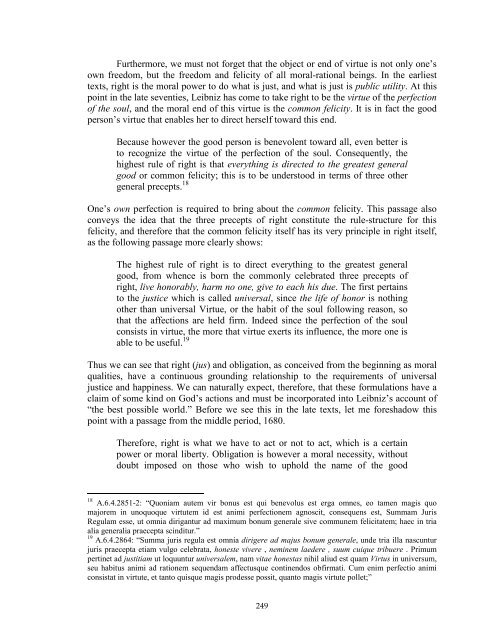Stony Brook University
Stony Brook University
Stony Brook University
Create successful ePaper yourself
Turn your PDF publications into a flip-book with our unique Google optimized e-Paper software.
Furthermore, we must not forget that the object or end of virtue is not only one’s<br />
own freedom, but the freedom and felicity of all moral-rational beings. In the earliest<br />
texts, right is the moral power to do what is just, and what is just is public utility. At this<br />
point in the late seventies, Leibniz has come to take right to be the virtue of the perfection<br />
of the soul, and the moral end of this virtue is the common felicity. It is in fact the good<br />
person’s virtue that enables her to direct herself toward this end.<br />
Because however the good person is benevolent toward all, even better is<br />
to recognize the virtue of the perfection of the soul. Consequently, the<br />
highest rule of right is that everything is directed to the greatest general<br />
good or common felicity; this is to be understood in terms of three other<br />
general precepts. 18<br />
One’s own perfection is required to bring about the common felicity. This passage also<br />
conveys the idea that the three precepts of right constitute the rule-structure for this<br />
felicity, and therefore that the common felicity itself has its very principle in right itself,<br />
as the following passage more clearly shows:<br />
The highest rule of right is to direct everything to the greatest general<br />
good, from whence is born the commonly celebrated three precepts of<br />
right, live honorably, harm no one, give to each his due. The first pertains<br />
to the justice which is called universal, since the life of honor is nothing<br />
other than universal Virtue, or the habit of the soul following reason, so<br />
that the affections are held firm. Indeed since the perfection of the soul<br />
consists in virtue, the more that virtue exerts its influence, the more one is<br />
able to be useful. 19<br />
Thus we can see that right (jus) and obligation, as conceived from the beginning as moral<br />
qualities, have a continuous grounding relationship to the requirements of universal<br />
justice and happiness. We can naturally expect, therefore, that these formulations have a<br />
claim of some kind on God’s actions and must be incorporated into Leibniz’s account of<br />
“the best possible world.” Before we see this in the late texts, let me foreshadow this<br />
point with a passage from the middle period, 1680.<br />
Therefore, right is what we have to act or not to act, which is a certain<br />
power or moral liberty. Obligation is however a moral necessity, without<br />
doubt imposed on those who wish to uphold the name of the good<br />
18 A.6.4.2851-2: “Quoniam autem vir bonus est qui benevolus est erga omnes, eo tamen magis quo<br />
majorem in unoquoque virtutem id est animi perfectionem agnoscit, consequens est, Summam Juris<br />
Regulam esse, ut omnia dirigantur ad maximum bonum generale sive communem felicitatem; haec in tria<br />
alia generalia praecepta scinditur.”<br />
19 A.6.4.2864: “Summa juris regula est omnia dirigere ad majus bonum generale, unde tria illa nascuntur<br />
juris praecepta etiam vulgo celebrata, honeste vivere , neminem laedere , suum cuique tribuere . Primum<br />
pertinet ad justitiam ut loquuntur universalem, nam vitae honestas nihil aliud est quam Virtus in universum,<br />
seu habitus animi ad rationem sequendam affectusque continendos obfirmati. Cum enim perfectio animi<br />
consistat in virtute, et tanto quisque magis prodesse possit, quanto magis virtute pollet;”<br />
249
















